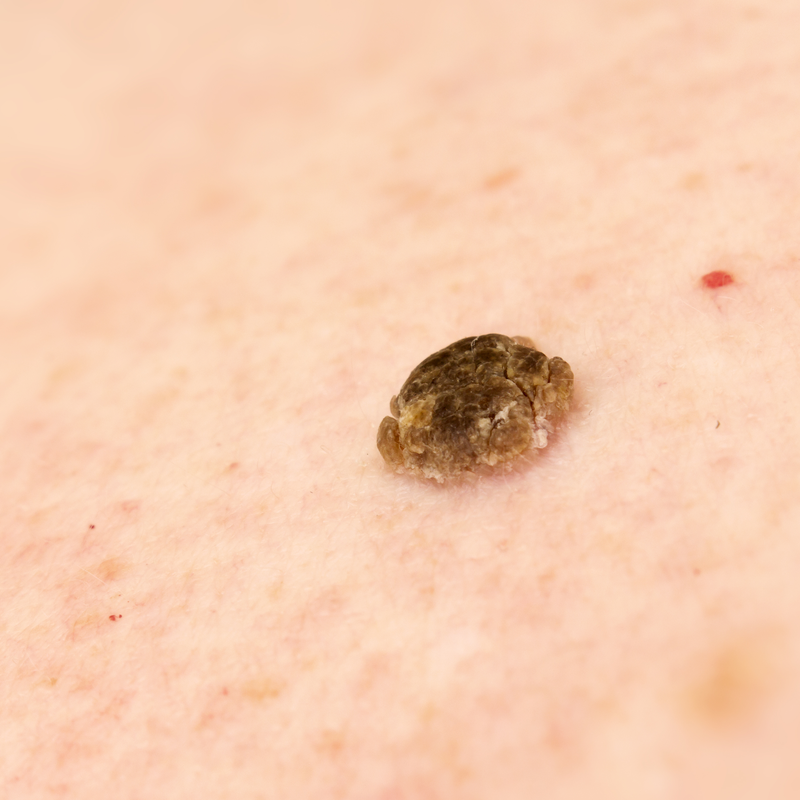
What is seborrhoeic keratosis?
Seborrhoeic keratosis are so-called age warts. Seborrhoeic keratoses are benign pigmented lesions of the skin. They often occur in older people, their appearance is sticky, with a verrucous, velvety, scaly or crusted surface.
Who is most often affected by seborrhoeic keratosis?
Especially in people over the age of 30, seborrhoeic keratosis is common. The older a person gets, the more pronounced the age warts become. Some people don't have any at all, while others have hundreds of them on their bodies.
How does seborrhoeic keratosis develop?
This is a proliferation of a certain tissue. This multiplication is caused by corresponding mutations, which however are not to be classified as malignant. The development of age warts is also genetically determined. Some people get them earlier and others later. Some people have many of these age warts and some people have none at all or only a few.
Actually, you can always assume that seborrhoeic keratosis is a normal skin change that occurs with increasing age. They are considered the most common skin growth, which is neither dangerous nor infectious. They cannot degenerate malignantly but can easily be confused with many types of skin cancer , so an age wart should always be assessed by a doctor .
What does a seborrhoeic keratosis look like?
The appearance of age warts can be quite different. Some are skin-coloured, some are whitish and some are brown or even black. They can be flat or very thick, with a smooth or rough surface .
How is seborrhoeic keratosis diagnosed?
In the diagnosis is usually made on the basis of the patient's age, the localisation and the course of the skin change. After an appropriate biopsy or excision, seborrhoeic keratosis can be confirmed in the pathology.
Is seborrhoeic keratosis dangerous?
The age warts in themselves are not dangerous. However, they make it very difficult to distinguish them from different types of skin cancer. Because seborrhoeic keratosis can look very different, they mimic many malignant skin cancers in appearance. More importantly , many different types of skin cancer can look just like age warts, which is why the cancers are sometimes missed because they are thought to be "harmless age warts".
What are the symptoms of seborrhoeic keratosis?
The age warts are especially common on the front of the arms, on the face, on the back of the hands and on the upper part of the body. They can take on different sizes, but usually remain in the range of millimetres. The colour can vary between whitish, light brown to black. They appear either singly or clustered on the body, but never on the soles of the feet or palms of the hands. Age warts feel greasy and stick out slightly from the skin. For the most part, they look as if they have been glued on. On the whole, age warts do not cause any discomfort. In the rarest cases, a mild itching occurs as a symptom.
How is seborrhoeic keratosis treated?
Since seborrhoeic keratosis does not usually cause any symptoms, it does not necessarily have to be removed as long as the age warts do not bother you. However, they often form on very unfavourable parts of the body where they can tear quickly and then bleed. If such a case occurs , the removal of the age warts should be considered. Removal is particularly advisable if a dermatologist cannot rule out with certainty that it is a malignant growth, especially black skin cancer. To remove seborrhoeic keratosis, the dermatologist has different methods:
- Icing (cryotherapy): This type of treatment is a simple and inexpensive one that does not leave any scars. During icing, the dermatologist treats the age wart with liquid nitrogen. Thanks to the cold, ice crystals form in the cells, which ensure that the cells die. Usually several sessions are required.
- Scraping (curettage): In scraping, the affected area of skin is locally anaesthetised. Then the dermatologist scrapes the age wart from the skin with an appropriate sharp spoon. However, this treatment takes quite a long time to heal, which is why it is no longer used very often and is not popular .Laser treatment: Under local anaesthetic, the age wart is irradiated with a laser. This vaporises the skin tissue. The wound may heal quickly, but in many cases a small scar remains.
Many people mistake the
age wart for a real wart and often try the
self-treatment. But this is completely
ineffective in most cases. This is because the age wart cannot be removed with ointments, solutions
or active ingredient patches.
How can seborrhoeic keratosis be prevented?
Since it is still not known how exactly an age-related wart develops, it is difficult and there are hardly any ways to prevent it. However, can be said with certainty that it is an age-related skin change that can affect any person over the age of 30 . Whether seborrhoeic keratosis is more or less pronounced often has to do with genetic factors. It has not yet been proven, but since sunlight generally accelerates skin ageing, it can be assumed that UV light sometimes causes age warts. In general, one should always make sure to use adequate sun protection .
Can seborrhoeic keratosis be treated with home remedies?
On no account is it advisable to try to treat age warts with home remedies such as acids or similar. Seborrhoeic keratosis does not react at all to these methods, sometimes they only become irritated and can become inflamed.
